- What We Do
- Agriculture and Food Security
- Democracy, Human Rights and Governance
- Economic Growth and Trade
- Education
- Environment and Global Climate Change
- Gender Equality and Women's Empowerment
- Global Health
- Humanitarian Assistance
- Transformation at USAID
- Water and Sanitation
- Working in Crises and Conflict
- U.S. Global Development Lab
Speeches Shim

October 2017
Social and Behavior Change in Global Health
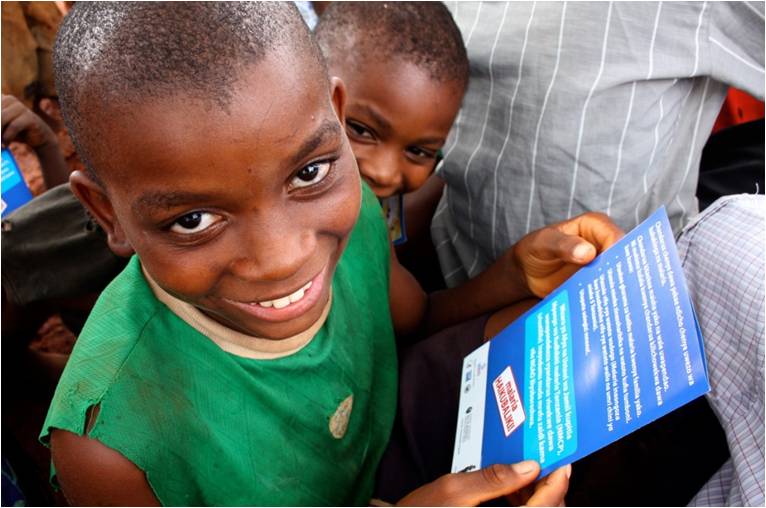
Community change agents work with school children, community members and pregnant women to prevent malaria throughout Tanzania. Using flipcharts, flyers, and instructions on hanging, caring for, and repairing nets, they build social norms and contribute to healthy behaviors.
Photo credit: Hannah Koenker, Tanzania/Courtesy of Photoshare
Social and Behavior Change
Global health professionals have long recognized that human behavior is influenced by culture, social norms and peer pressure. Understanding what drives people’s behaviors entails looking at how people are socialized, what their belief system is and who has influence over whom.
Gender roles, for instance, can determine how young women and men relate to one another. In some societies, women are expected to get married young and start a family early, while men are encouraged to be the breadwinners. Social pressure can make it hard for young women to pursue higher education or for men to choose to be stay-at-home dads.
For decades, the U.S. Agency for International Development (USAID) has been at the forefront of social and behavior change (SBC) research and programming. Whether to increase rates of immunization, breastfeeding or handwashing, detection and treatment of tuberculosis, or uptake of health insurance, social and behavior change approaches are necessary to promote healthy behaviors in different populations.
These approaches consist of a range of tactics, backed by solid social science research, that can transform social norms and cultural practices over time. USAID’s investments in SBC over the past 35 years have supported interventions that focus on creating safe spaces for discussion, using mass media for targeted campaigns, mobilizing and engaging communities, influencing policy and promoting empowerment through mentoring and modeling behaviors.
More recently, SBC programs have also leveraged the power of new media and mobile technology to reach target audiences and those who influence them. USAID’s investments in SBC seek to strengthen the capacity of national governments to coordinate and lead on their priority health activities, which complement investments in health service delivery.
SBC has the power to catalyze shifts in socio-cultural norms as well as sustained changes in individual and collective health behaviors. Ultimately, SBC programming can save lives.
Which Behaviors Can Help Prevent Child and Maternal Deaths?
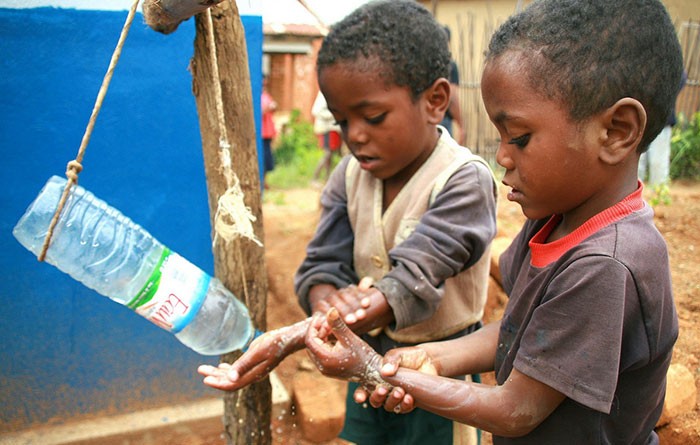
Photo credit: Shahbaz Fawbush / USAID Water Office.
USAID is working with partners around the world to improve maternal and child survival and save 15 million children and 600,000 women between 2012 and 2020. To achieve this goal, USAID works with partners across multiple sectors of society and employs a diverse portfolio of interventions, including social and behavior change approaches. USAID identified 10 key "Accelerator Behaviors" with the potential to accelerate progress toward that goal. These behaviors are simple – like ensuring timely vaccination of a newborn, promoting exclusive breastfeeding for the first six months of a child’s life or promptly treating diarrhea or pneumonia – and address major causes of maternal and child deaths. Learn how USAID is working to increase the use of accelerator behaviors in maternal and child survival priority countries.
Engaging and Educating the Community in Nigeria
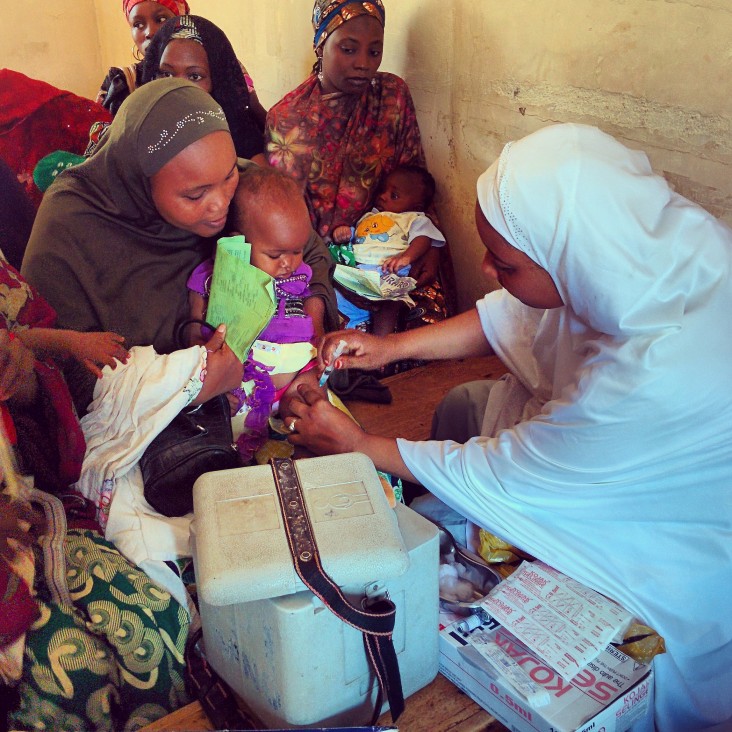
A woman administers a vaccine to an infant in Nigeria. Photo credit: eHealth Africa, Courtesy of Photoshare
Community education and outreach can raise awareness, transfer knowledge and skills and catalyze behavior change in global health. In Nigeria, this focus on social and behavior change effectively changed a community’s attitude toward immunizations, allowing more children to access healthcare. Adamu Mamman, an imam in Nigeria's Bauchi state, never trusted immunizations. USAID wanted to help the local health officials immunize all the kids in the area, and Mamman and "community influencers" like him were the key to their strategy. USAID provided technical support for a series of trainings that pointed out that a child with polio is a lifelong burden to his or her parents and that diseases such as measles could also bring the chance of permanent disability and a life of economic and emotional hardship for their parents. Mamman not only changed his mind, but also, he encouraged his entire constituency in the scholastic community to do the same, and nearly all children in the community were immunized that year. Read the full story.
Breastfeeding in Ghana
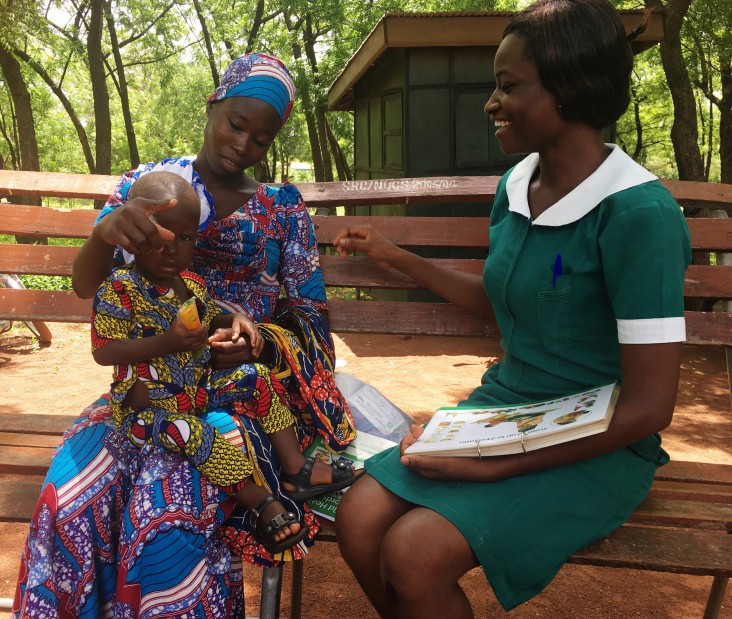
Mme Gipi and her son sit with a local health worker during one of their regular check-ins. Photo credit: SPRING/Ghana
In Ghana, 98 percent of women report having ever breastfed their children, yet proper infant and young child feeding practices are not widely followed. As part of a USAID-funded effort to improve nutrition, health workers in Ghana are helping to educate pregnant women and new mothers on the benefits of proper breastfeeding and change breastfeeding behavior among new moms. Madam Kusumi Gipi, a new mother in rural Ghana, took part in one-on-one sessions with local health workers who used counseling cards and demonstrated techniques to teach her proper breastfeeding practices. Through this outreach, Madam Gipi learned about the importance of proper positioning, early initiation of breastfeeding, exclusive breastfeeding for the first six months, and continued breastfeeding with adequate and appropriate complementary feeding from six months through at least the first two years of life. These behaviors are effective, evidence-based ways to reduce stunting and other forms of undernutrition. Read the full story.
Women’s and Children's Health: A New Roadmap for Building, Reporting, Assessing and Applying Evidence
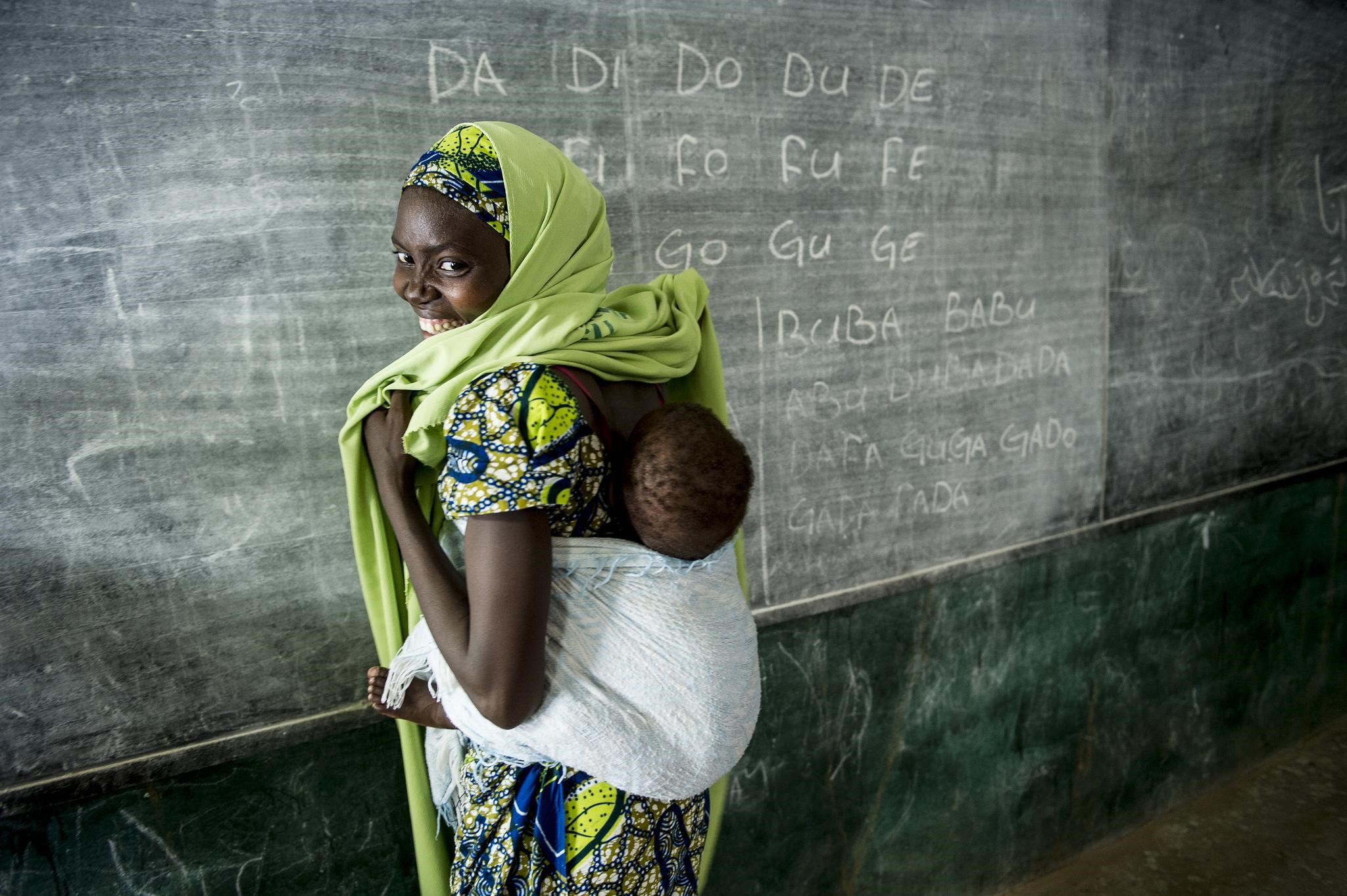
Mother and child. Photo credit: Karen Kasmauski/USAID's Maternal and Child Survival Program
A World Health Organization (WHO)-led initiative that includes USAID, various UN agencies and other prominent partners, is working to improve how the social and behavior change sector builds, reports, assesses and applies evidence for social, behavioral and community engagement interventions for maternal, newborn and child health. This work will strengthen the WHO guideline development process for complex interventions; develop a prioritized global research agenda for Social, Behavioral and Community Engagement interventions for maternal, newborn and child health; and develop program reporting standards for various programs and research efforts. Collectively, this work will identify key research needs, ensure that evidence generated by programs and research is comparable and sufficiently detailed and that WHO guidelines for complex interventions are taken into consideration. Find out more here.
Malaria and Social and Behavior Change
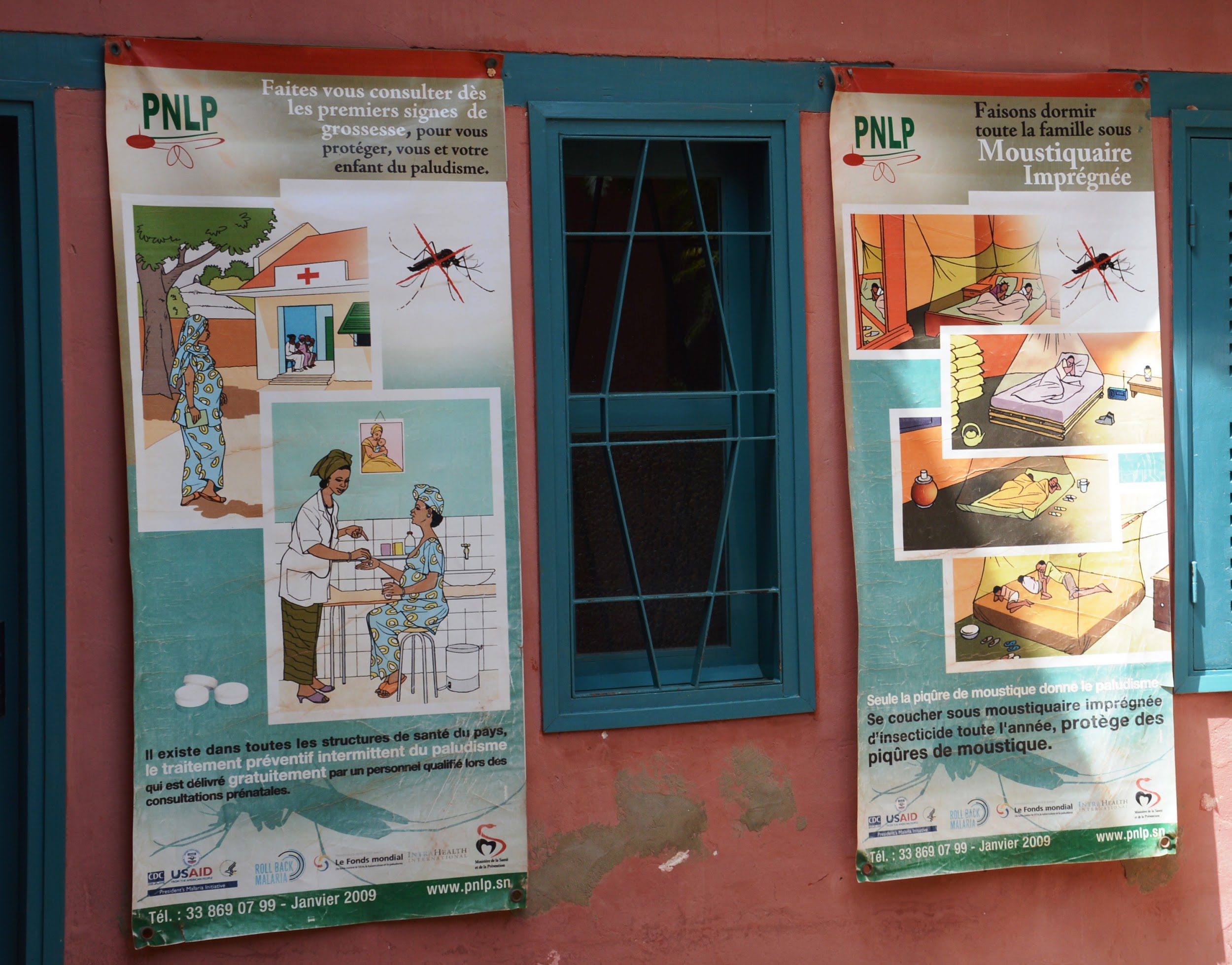
Photo credit: Educational poster on malaria. Courtesy of USAID
Take a quick peek at the Malaria Social and Behavior Change Communication Evidence Package, which includes a searchable online database, fact sheets and infographics that compile and highlight key SBC successes on malaria outcomes. Key findings from compiling the database have been highlighted in a series of infographics and fact sheets on several malaria technical areas, including:
Case Management
Insecticide-treated Nets
Service Provider Behaviors
Family Planning and Social and Behavior Change

Radio anchor Oche discusses issues with a family planning expert, Mariam Momoh, during a live program about family planning on Wazobia FM in Abuja, Nigeria. Photo credit: © 2012 Akintunde Akinleye/NURHI, Courtesy of Photoshare
High Impact Practices (HIPs) are evidence-based family planning programming practices that are vetted by experts against specific research criteria and then documented in an easy-to-use format. The Family Planning High Impact Practices consortium recently released two new HIP briefs.
The first HIP brief is focused on community group engagement and encouraging group dialogue to promote healthy sexual relationships and address social norms that promote child marriage and early sexual debut and contraceptive use. Community group engagement techniques are used as part of a package of interventions to influence individuals, family and/or peer groups and the community simultaneously. For example, the USAID supported Gender Roles, Equality and Transformations (GREAT) Project used community group dialogue and engagement to facilitate reflection on social expectations related to being a boy or girl and how these norms influence sexual decision-making and access to health services. The community engagement component involved a set of educational tools and a radio serial drama to promote dialogue and learning between groups of adolescents between 10 and 19 years old and members of their communities. The process was designed to engage community members and leaders to reflect on community norms, identify key issues and develop and execute a plan of action. Most people who participated in the GREAT Project showed improved attitudes toward reproductive health topics and family planning use increased by 10 percent. In addition to a summary of the current evidence for community group engagement interventions, the HIP brief also includes practical tips for implementing, monitoring and evaluating these interventions to successfully engage communities in behavior change.
The second HIP brief focuses on using mass media to support healthy reproductive behaviors. Mass media is unique in its ability to address norms and behaviors that exist outside the health system and to reach those who may not generally access clinic-based health services. For this reason, priority audiences for reproductive health-focused mass media include young people; men (as both users and supporters of family planning); and socially marginalized groups, such as ethnic minorities that are historically excluded by others. The brief provides a summary of current evidence for mass media programming as well as tips on how mass media interventions can be combined with other evidence-based social and behavior change approaches to improve knowledge, attitudes and behaviors among community members that influence couples’ decisions around timing and spacing of pregnancies, including healthcare providers, parents and community leaders. Implementers of successful mass media programming draw upon both behavior change theory and formative research to design activities that are targeted and interactive, with attention to both individual-level behaviors and the social norms and dynamics that influence them.
Addressing Zika through Social and Behavior Change
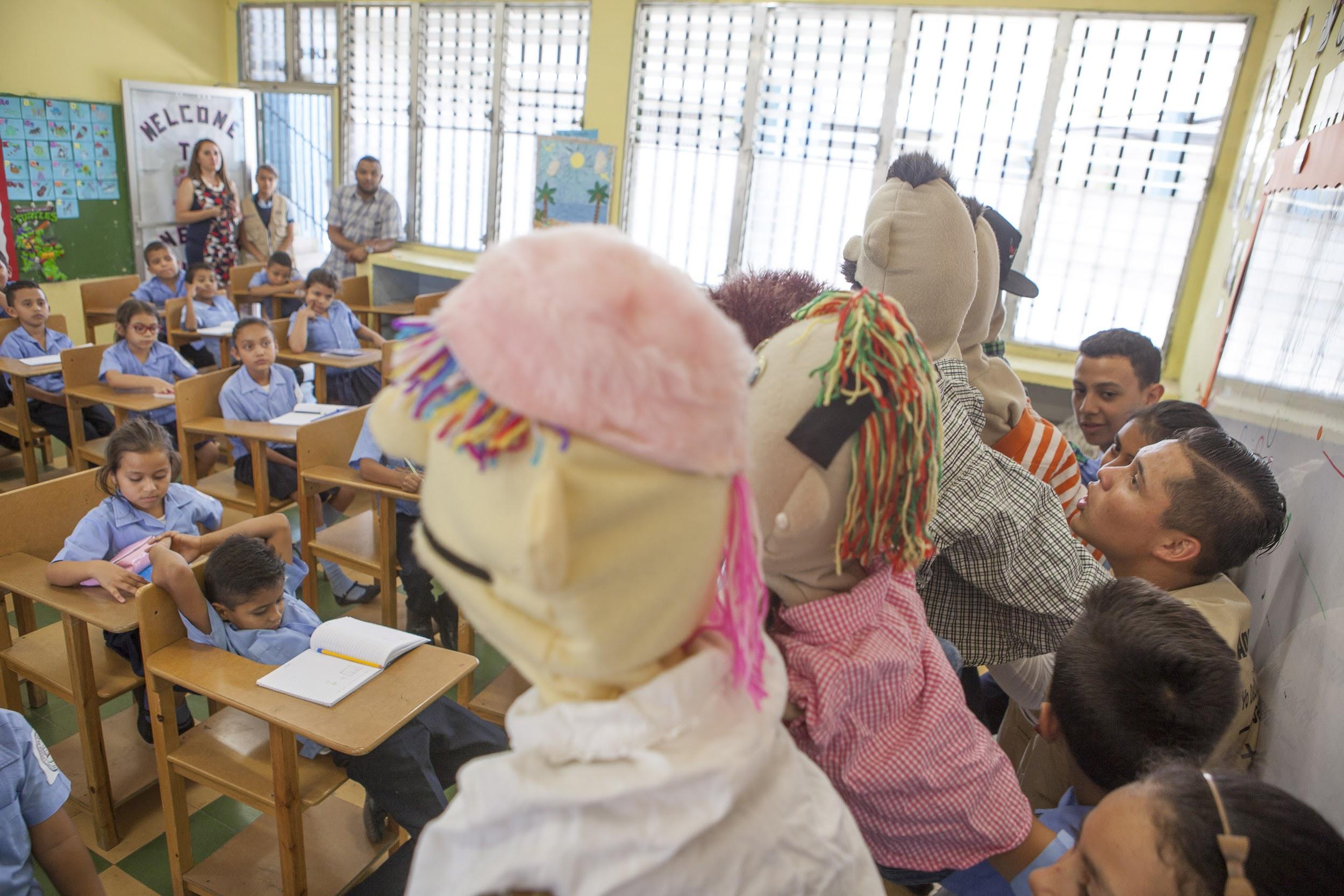
Student leaders at the Juan Molina Educational Center in Tegucigalpa, Honduras, use puppets to teach younger children about the Zika virus. Photo credit: Brendan Bannon for USAID/Photoshare
Social and behavior change plays a crucial role in responding to infectious disease outbreaks such as Ebola and more recently, Zika. While scientific evidence around a disease rapidly emerges and longer-term solutions like vaccines are sought, SBC can dispel rumors, calm fears and provide critical information to help halt the spread of the disease.
SBC is a fundamental approach within USAID’s support to Zika-affected countries in Latin America and the Caribbean. USAID and its partners conduct continuous research on knowledge, attitudes and practices surrounding Zika in this part of the world to inform their SBC messaging, including innovative methodologies such as rumor monitoring via social media. At the national level, USAID is assisting governments of affected countries to develop strategic communication plans for Zika as well as launching mass media campaigns to increase risk perception, knowledge of transmission routes, and adoption of preventative measures. At the community level, USAID is engaging individuals, households and their networks in the prevention of Zika through door-to-door SBC and community mobilization campaigns in more than 20 Latin American and Caribbean countries.
A wide range of prevention and preparedness materials created by partners working to stop the spread of Zika can be found on the Zika Communication Network, a knowledge sharing platform designed to facilitate a coordinated response to the epidemic.
Lastly, USAID is supporting the development, testing and scale-up of 26 ground-breaking innovations to prevent, detect and respond to future infectious disease outbreaks as part of its Combating Zika and Future Threats Grand Challenge. These potentially game changing solutions cut across various approaches, including behavior change communication. For example, the Institute for Global Environmental Strategies' Mosquito Challenge Community Campaign is using the GLOBE Program's Mosquito protocol to engage school-age citizen scientists to collect and share mosquito data in Peru and Brazil.
New Social and Behavior Change Awards
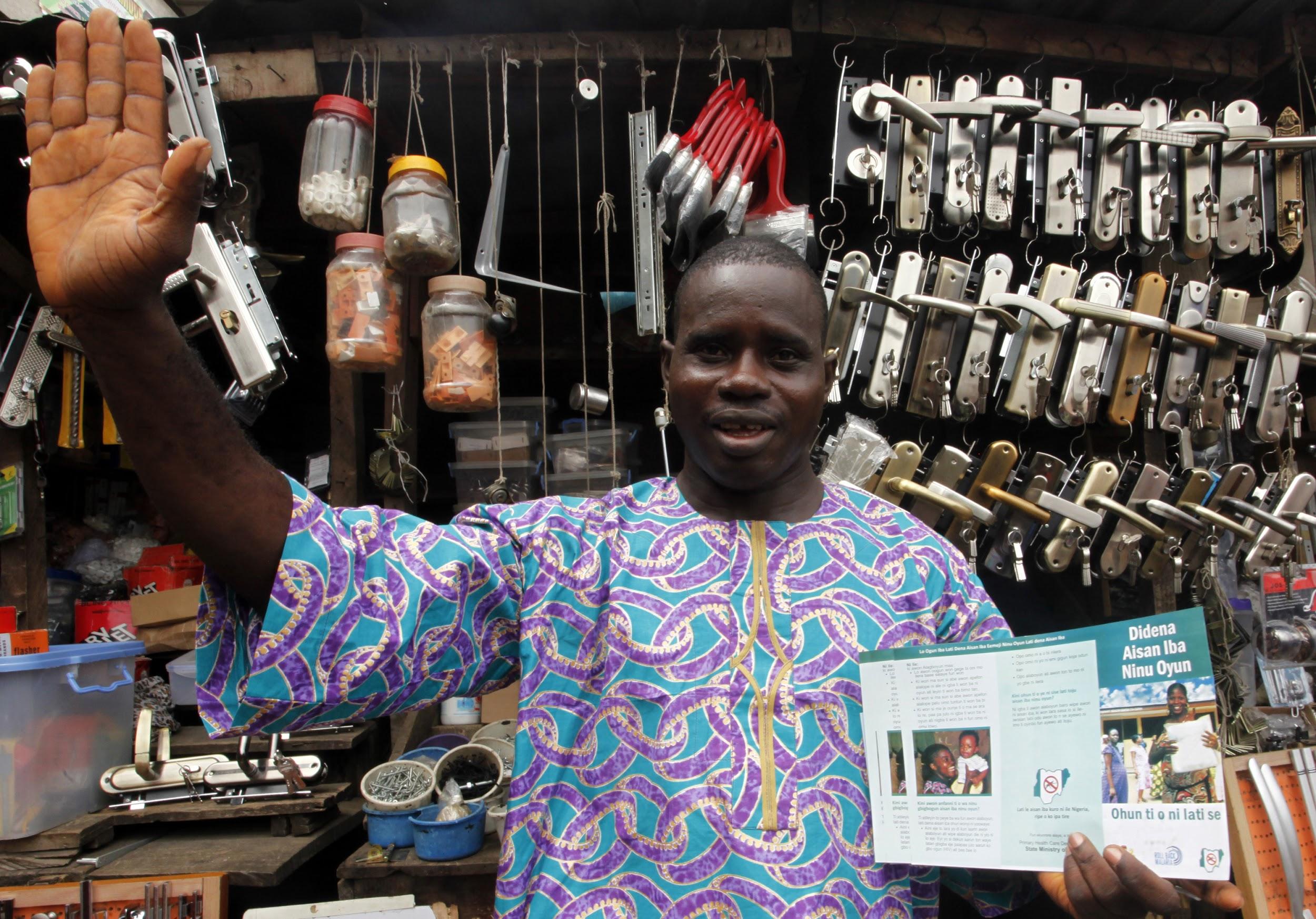
Student leaders at the Juan Molina Educational Center in Tegucigalpa, Honduras, use puppets to teach younger children about the Zika virus. Photo credit: Brendan Bannon for USAID/Photoshare
Breakthrough Action and Breakthrough Research are the two new awards intended to develop and advance Social and Behavior Change learning and programming. The projects will work to strengthen the capacity of individuals, institutions and country systems to respond to the changing communication landscape and evolving behavior change needs. Find out more details about these two five-year awards and how they complement each other here:
GLOBAL HEALTH VOICES
Podcast
PODCAST –"Behavior Change Approaches in Global Health"
Listen to a podcast conversation with Elizabeth Fox, USAID's Deputy Coordinator Maternal and Child Survival USAID.
Download a transcript of this podcast [PDF, 78KB].
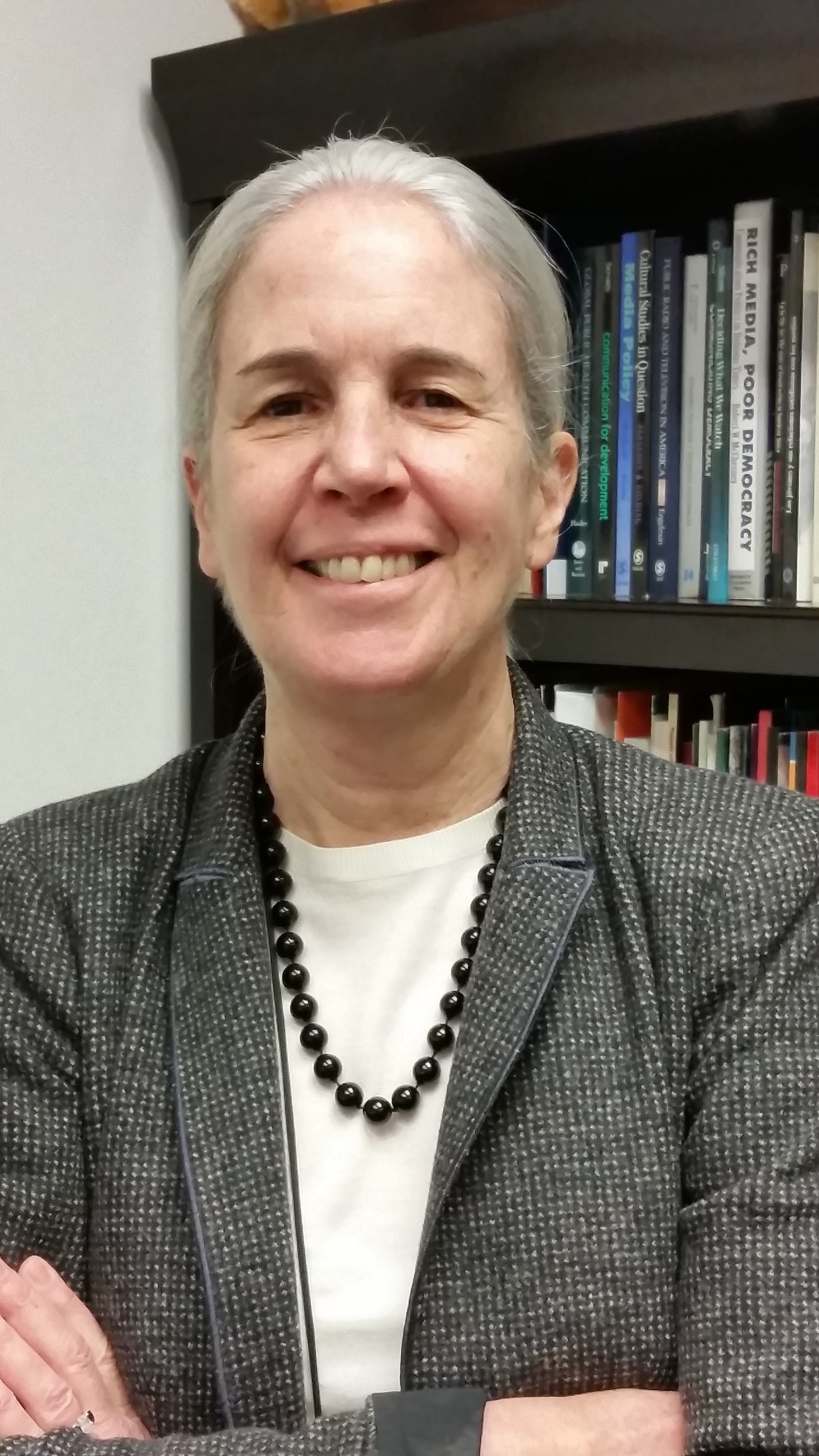
RECENT HIGHLIGHTS & LOOK AHEAD
Updated Health Research Program website
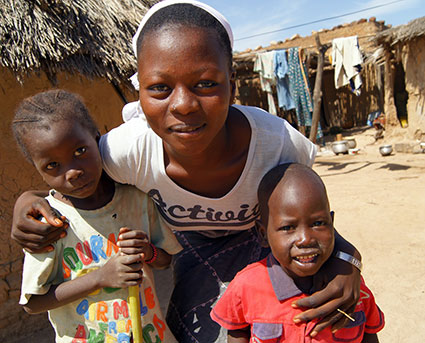
USAID's Global Health Research Program supports real-world research and translates findings into effective health interventions that can be adapted globally. Learn more about our work on respectful maternity care, household air pollution, possible serious bacterial infections in infants, and much more. View the updated website to learn more.
UN General Assembly: TB Is a Fight that Is "Possible to Win"
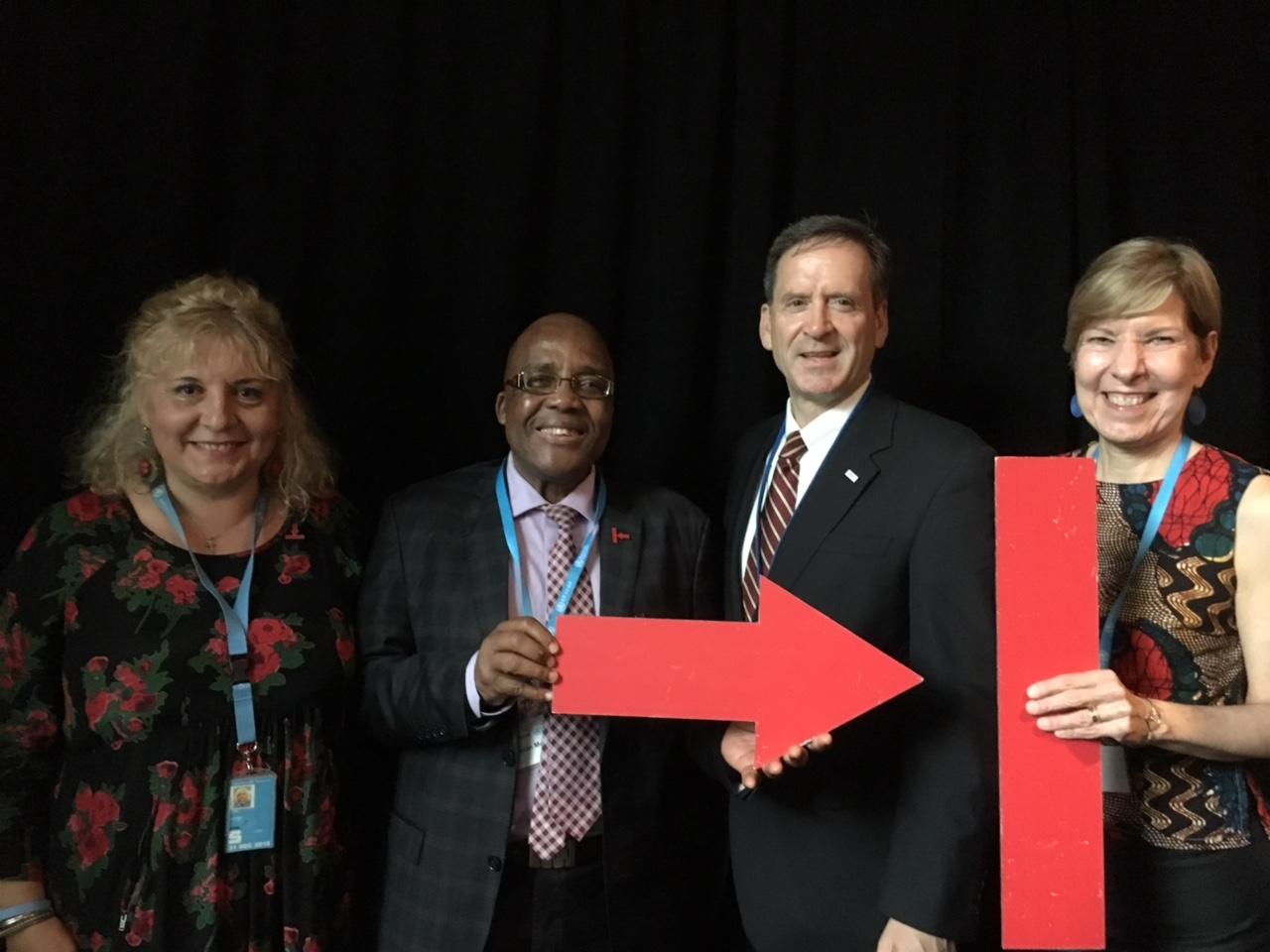
Photo credit: (From left) Stop TB Partnership Executive Director Dr. Lucica Ditiu; South Africa Minister of Health and Stop TB Coordinating Chair Dr. Aaron Motsoaledi; USAID Administrator Mark Green; and RESULTS Executive Director and Stop TB Coordinating Board Vice Chair Joanne Carter.
USAID Administrator Mark Green shared the Agency’s strong commitment to ending TB at a high-level reception on the margins of the UN General Assembly in New York last September. The Administrator was joined by WHO Director General Tedros Ghebreyesus; South Africa’s Minister of Health and Stop TB Partnership Coordinating Board Chair Dr. Aaron Motsoaledi; and local TB survivor and advocate Kate O’Brien. Sharing his excitement for taking on the challenge of a fight that he labeled, “possible to win,” the Administrator called on everyone to work in partnership to prevent TB transmission and renew efforts to find missing tuberculosis cases; to use existing resources to turn evidence into policy; and to expand the development of new TB diagnostics, drugs and vaccines. The event was hosted by the Stop TB Partnership and the WHO. Please read Administrator Green's full remarks here.
Fighting Ebola Grand Challenge Innovation Comes to Life in Liberia
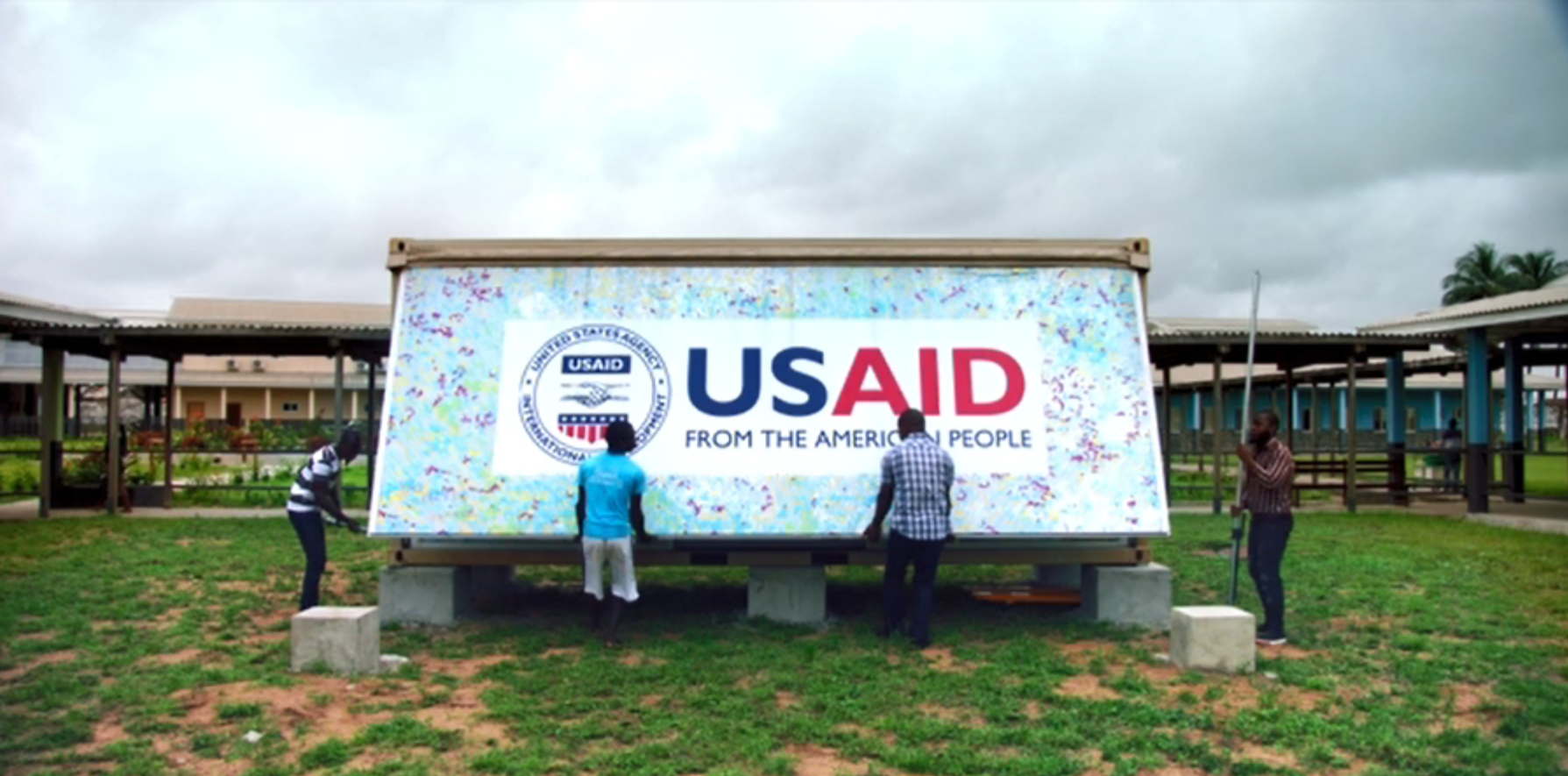
Through support from USAID’s Fighting Ebola Grand Challenge for Development, Baylor College of Medicine developed the Emergency Smart Pod, a rapidly deployable patient care setting. The Pod is portable, lightweight and can be expanded to a full-size treatment center in less than five minutes with just four people. The unit is easily transported on the back of a truck, and can be driven to wherever it is needed. In addition, the Pod has features such as controlled access-entry, waste disposal, patient and supply tracking systems and decontamination systems. While the Pod was initially designed to combat Ebola, it can function in an epidemic or natural disaster as well as for routine care. In September 2017, the Pod was deployed to ELWA hospital in Liberia. ELWA used the Pod to prepare Ebola survivors for cataract surgeries, and going forward, they will use it as an isolation unit for infectious patients. Watch the Pod in action in this newly debuted video of the Fighting Ebola Grand Challenge.
East Africa Digital Health Conference Launches Development of Regional Roadmap
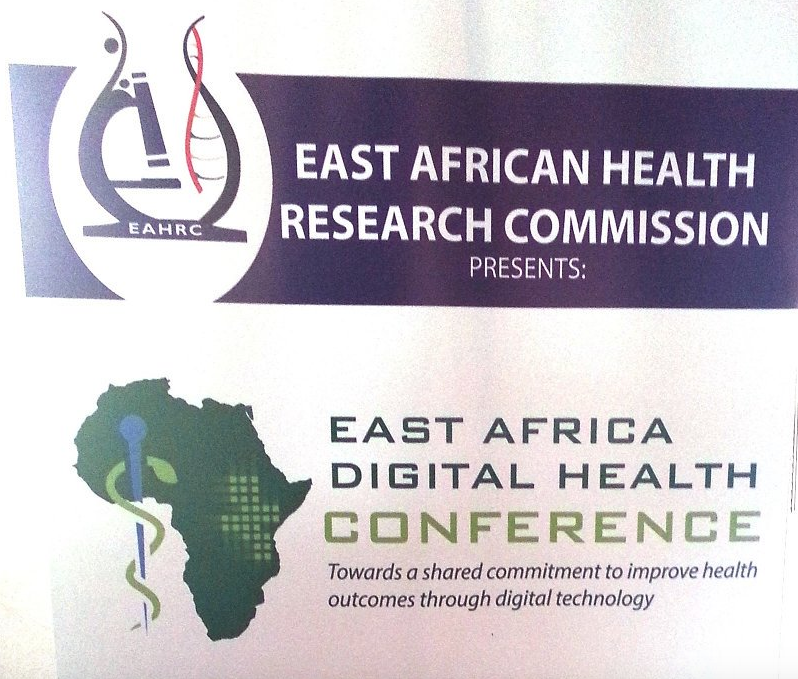
In September, USAID supported the East African Health Research Commission of the East Africa Community (ECA) to start the development of the East African Digital Health Roadmap. The roadmap goals are to support transformation of health systems in the EAC region through the successful use of digital technologies, information ecosystems, governance, policies and regulations and infrastructure necessary for scaling uptake and utilization of digital technology and solutions in health. This regional approach will address issues of fragmentation and will lead to more cost-effective digital health systems that are able to share data more effectively.
The regional role will help East African countries address gaps in their current infrastructure and allow countries to leverage each other's expertise. Comparisons were drawn to East Africa's global leadership in the development and scale of mobile money and digital financial services with a call stating: “If they accomplished it in finance, they should accomplish it in health.” This roadmap will be a formal product of the EAC and will be submitted to both the six Ministers of Health and six Presidents for clearance and adoption.
Launch of Digital Square
USAID and the Bill & Melinda Gates Foundation are among the donors behind Digital Square, a new initiative launched by PATH at the end of September. This new initiative, comprised of 40+ partner organizations, encourages more efficient investments in digital health technology solutions in low- and middle-income countries through an innovative co-investment model. “Co-investment is a simple but powerful concept. Development dollars are scarce, by coordinating them, we can maximize the impact of our financial investments,” said Dykki Settle, Director of Digital Health at PATH.
"Digital Square innovates by aligning donor and partner funds behind technology solutions that we know work," said Digital Square Director Lesley-Anne Long. The initiative offers a platform for individuals and organizations to confidently coordinate their funding and technical expertise into a suite of proven, adaptable digital health technologies. These solutions can be scaled across an entire country and even between countries, allowing health systems to connect seamlessly, sharing better data to create better health outcomes.
Digital Square also helps to support countries to develop the skills they need at all levels – from national government leaders to local healthcare workers – to bring these technologies to scale. Connect with Digital Square at digitalsquare@path.org or follow us on Twitter at @DigitalSQR.
Global Health Science and Practice Journal
The September edition of the Global Health Science and Practice Quarterly Journal is now available here.
MEDIA MENTIONS AND RESOURCES
Read a blog post by Admiral Tim Ziemer on Securing Global Health through U.S. Leadership.
Check out the Journal of Health Communication September supplement dedicated entirely to the lessons learned on social and behavior change communication during the Ebola crisis.
View the USAID- and HC3-supported Journal of Acquired Immune Deficiency Syndromes (JAIDS) supplement that highlights the role effective health communication plays in HIV treatment outcomes.
New Single-Day Pill for HIV Treatment Promises More Bang for Less Buck
Video: Behavioral Science and International Development
Video from WHO Medical Devices Forum and USAID's Grand Challenges.
Read a story about combatting fistula in Mali
Hear Irene Koek, USAID's Acting Assistant Administrator for Global Health talk about a new strain of malaria in Southeast Asia
Watch the new health finance video by USAID's Development Credit Authority.

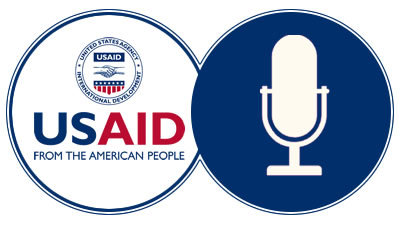
Comment
Make a general inquiry or suggest an improvement.